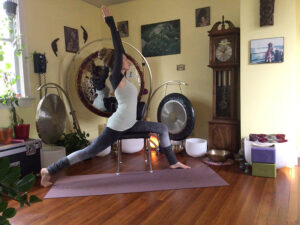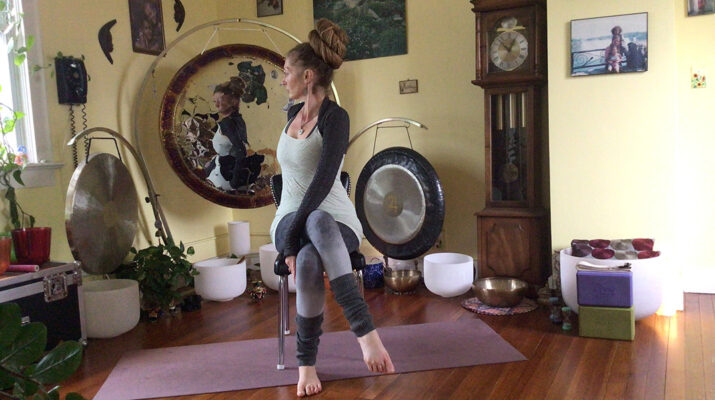Although mostly a seated activity, chair yoga promotes good health
By Deborah Jeanne Sergeant

For people with limited mobility, practicing yoga seems unattainable. But chair yoga may offer an entry point.
Chair yoga is an informal term that may refer to practicing yoga, including some modified poses, entirely while seated or it can also refer to using a chair more like a yoga prop for people capable of standing but who need support to augment their balance.
Makaela “Kay” Colner, doctor of physical therapy, leads the inpatient yoga therapy program at University of Rochester Medical Center department of physical medicine and rehabilitation.
“What we’ve done is we’ve started an adaptive yoga program that’s performed seated,” she said. “It’s a little bit different than a chair yoga class, where it’s used as a prop. In adaptive, you’re applying subtle principles in yoga but making it accessible to anyone. Maybe they’re not ambulatory.”
Participants remain in their wheelchair and don’t transfer to a different seat or to the floor. The goal is to promote parasympathetic activation, the part of the nervous system in charge of resting, repairing and healing.
“A lot of our patients at Strong are stressed because they’re adapting to a life-changing injury, adapting to how they’re going to live their lives,” Colner said. “My group sessions are targeted to help people take a deep breath and rest deeply and help them reprocess what they’re going through and realize that they’ll have a rich life after they get out of the hospital.”
The sessions include breathwork and some modified movements, but achieving a restful state and promoting mental health are the true motivation for offering the class.
Sandra Kurzdorfer, certified yoga instructor and owner of Sunflower Vibrations in Rochester, said that for any person, sitting too much can weaken the pelvic floor and tighten the hips, back, shoulders and neck, leading to misalignment.
“Those of us stuck at a desk, doing stretches helps to alleviate pain associated with sitting so long,” Kurzdorfer said.
Rolling out a yoga mat in one’s cubicle isn’t practical but learning a few chair yoga moves can help desk-based workers breathe deeper, relax, stretch and strengthen.
“It’s great for people who can’t do weight bearing exercise such as those who’ve had foot or knee surgery,” Kurzdorfer added. “With any lower extremities, you can do all sorts of poses without being weight bearing.”
Elizabeth Hornak, certified yoga instructor at JCC Rochester, leads gentle yoga classes, mostly attracting older participants.
“As we age, our muscles will contract,” Hornak said. “We’re looking to lengthen and strengthen. Breath is a huge part of yoga. It’s incredibly nourishing and healing for tissues.”
Hunching over decreases lung activity, but Hornak said that yoga poses can help people learn to breathe more deeply.
She views chair yoga as a way to help keep participants safer, more active and able to explore their potential. Even if a pose isn’t perfect or traditional, it keeps participants moving.
“One of the ‘foundational’ moves is cat-cow,” Hornak said. “You’re on all fours and as you breathe, you bring your spine into flexion and extension. You can do cat-cow seating, standing or on all fours. It’s an incredibly versatile pose.”

